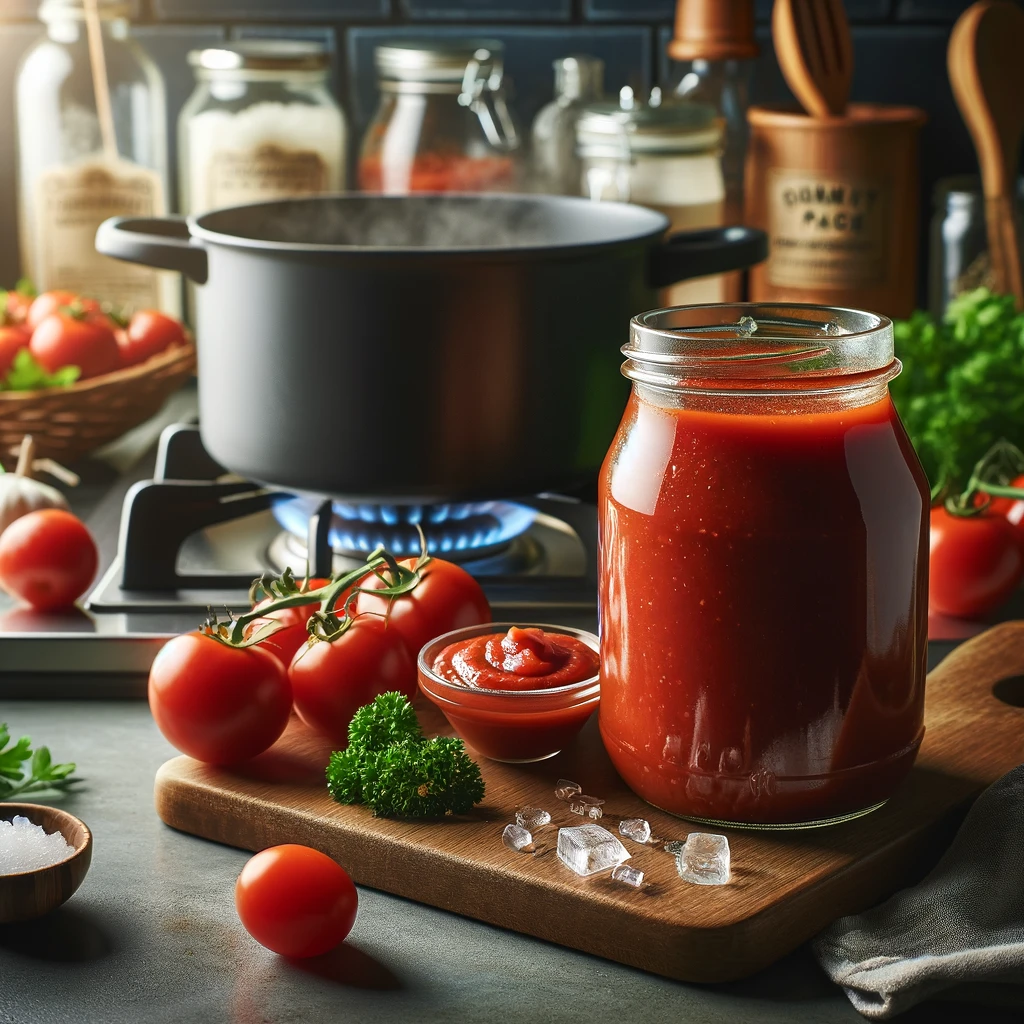Quality Tomato Paste – Best Quality Tomato Paste – Premium Tomato Paste – Best Tomato Paste – High Quality Tomato Paste – High-quality Tomato Paste – Gourmet Tomato Paste – Artisanal Tomato Paste – Natural Tomato Paste
Introduction to Premium Quality Gourmet Tomato Paste
Gourmet Tomato Paste, a staple in kitchens worldwide, acts as a concentrated source of tomato flavor. Artisanal tomato paste’s significance in the culinary arts is immense, serving as the backbone of numerous sauces, soups, and dishes. It imparts a rich, umami-packed essence that elevates the taste profile of any meal. Unquestionably, not all tomato paste is created equal. Understanding what constitutes high-quality tomato paste involves more than recognizing a thick, red concentrate. It’s about appreciating the subtleties that distinguishes Gourmet tomato paste from its ordinary counterparts. Moreover, natural tomato paste is highly sought after by chefs and consumers alike.
Critical Factors
Artisanal tomato paste depends on several critical factors, including the type of tomatoes used, the processing methods, and the absence of unnecessary additives. In other words, high-quality tomato paste should capture the essence of ripe, sun-kissed tomatoes. Eventually, good tomato paste will be concentrated into a smooth and rich paste. The gourmet tomato paste becomes vibrant in color and robust in flavor. This introduction sets the stage for a deeper exploration into the world of premium tomato paste, aiming to equip readers with the knowledge to discern, select, and use the finest tomato paste in their culinary endeavors.
Significant Qualities
The significance of natural tomato paste goes beyond culinary uses. It serves as a concentrated source of vitamins, minerals, and antioxidants. Therefore, understanding Gourmet tomato paste quality can enhance dining experiences by adding depth and complexity to dishes. Only the finest ingredients can achieve the best quality tomato paste.
Discover More about High-Quality Tomato Paste
As we delve into the subsequent sections, we will uncover the layers that contribute to high-quality tomato paste. From selecting the perfect tomatoes to understanding the intricacies of the production process and mastering best practices for storage and usage, this article aims to be a comprehensive guide. Whether you’re a seasoned chef or a home cook, the insights provided will help you make informed choices. These choices will ensure that the organic tomato paste you use brings out the best in your culinary creations.

Contact us on WhatsApp for Quotation or additional Information.
Understanding Tomato Paste
Premium Tomato Paste has become a staple in kitchens worldwide. It deepens flavors in various dishes. But what exactly is Premium Tomato Paste, and how did it become so essential in cooking? This section explores the essence of tomato paste, tracing its origins and defining its role in modern cuisine.
Definition and Basic Information
At its core, natural tomato paste is a concentrated form of tomatoes. In other words, it involves cooking down tomatoes for several hours to reduce moisture. Followed by straining; to remove the skins and seeds. Tomato flesh is further cooked to concentrate its flavors and achieve a thick, rich paste. This process intensifies the tomato’s natural flavors and color, resulting in a deep red, almost burgundy hue. The concentration process enhances the taste and nutritional value, making Natural Tomato Paste a rich source of vitamins, minerals, and antioxidants, particularly lycopene.
Historical Background
Artisanal tomato paste has a rich history, originating in the Mediterranean, especially Italy, where it became a staple in premium cuisines. This paste is crafted from abundant, high-quality tomatoes, reflecting centuries of tradition and culinary expertise. Historically, people used natural tomato paste to preserve tomatoes for year-round use, especially in regions with distinct growing seasons. Families would gather the ripest tomatoes at the peak of the season, cook them down into paste, and then spread this paste out on large wooden boards to dry under the sun—a method still practiced in some parts of Italy and the Mediterranean today.
Traditional Method
The traditional method of making organic tomato paste provided a year-round supply of tomato flavor. It became integral to the culinary traditions of the regions, embedding itself in the fabric of their food culture. In other words, As culinary practices evolved, so did the production of tomato paste. Modern methods now allow for mass production without sacrificing the quality and flavor that were hallmarks of the traditional paste.
Versatility
Gourmet Tomato paste has transcended its humble beginnings to become a global kitchen staple. Its ability to add depth, color, and richness to dishes has made it an indispensable ingredient in cuisines worldwide. From the Italian marinara sauces to Indian curries and beyond. Its versatility and concentrated flavor profile enable chefs and home cooks to infuse their dishes with a robust tomato essence. This can elevate a recipe from good to great.
Appeal of Tomato paste
The journey from simple, sun-dried tomatoes to the versatile culinary ingredient we know today showcases tomato paste’s enduring appeal. Understanding its origins and production methods lays a foundation for appreciating its role in cooking. This knowledge encourages a more mindful approach to its use. Whether added to a complex sauce or used as a base for a simple stew, artisanal tomato paste can transform the ordinary into the extraordinary. It underscores the importance of this vibrant red concentrate in the culinary world.

Contact us on WhatsApp for Quotation or additional Information.
Key Ingredients for High-Quality Tomato Paste
The quest for high-quality tomato paste begins with its core ingredient: tomatoes. However, not all tomatoes are created equal, especially when producing a rich, flavorful paste. This section explores the types of tomatoes best suited for paste and the importance of freshness and quality in creating a superior product.
Types of Tomatoes Best Suited for Artisanal Tomato Paste
The foundation of exceptional Artisanal tomato paste lies in selecting the right tomato varieties. Tomatoes destined for paste should be meaty, with high solids content, low moisture, and robust flavor. Varieties such as Roma, San Marzano, and Amish Paste are renowned for their thick flesh and concentrated taste. They are ideal candidates for paste production. These types exhibit less seed and water content compared to other varieties, which translates into a denser, more flavorful paste.
Choosing the Best Varieties
The choice of tomato variety is pivotal not only for flavor but also for the best paste’s color and consistency. Tomatoes with deep red hues and strong acid-sugar balance yield a paste that’s both visually appealing and rich in taste. The inherent qualities of these tomatoes ensure that the final product is of the highest standard, embodying the essence of ripe tomatoes in a concentrated form.

Importance of Freshness and Quality of Tomatoes
Beyond the variety, the freshness and quality of the tomatoes are crucial determinants of the paste’s quality. Tomatoes should be harvested at their peak ripeness when they are most flavorful and nutritious. The commitment to using fresh, high-quality tomatoes is essential for producing good natural tomato paste. This ensures that the paste not only displays a vibrant color and a rich, smooth texture but also retains the nutritional benefits of the tomatoes, including vitamins, minerals, and antioxidants.
Quality of the Tomatoes
The quality of the tomatoes directly affects the overall taste profile of the paste. Tomatoes that are grown in nutrient-rich soil and harvested at the optimal time exhibit a superior flavor and aroma. For high-quality tomato paste, organic and sustainably farmed tomatoes are often preferred due to their improved taste and environmental benefits. These tomatoes are cultivated without synthetic pesticides or fertilizers, which contributes to a cleaner, more pronounced natural tomato flavor in the paste.
Crafting High-Quality Tomato Paste
Crafting high-quality tomato paste hinges on the meticulous selection of suitable tomato varieties and the utilization of fresh, premium tomatoes. These components synergize to produce a paste that elevates dish flavors while providing nutritional advantages. Recognizing the importance of these fundamental components is crucial for anyone aiming to comprehend or produce top-tier tomato paste.
Explore the intricacies of Quality Tomato Paste
As we continue to explore the intricacies of quality tomato paste, it becomes clear that the choice of ingredients is just the beginning. The production process itself plays a critical role in determining the paste’s quality, which we will delve into in the next section.
Contact us on WhatsApp for Quotation or additional Information.
The Production Process of Quality Tomato Paste
The journey from ripe, sun-kissed tomatoes to the rich, concentrated essence in a jar of quality tomato paste is both an art and a science. This section outlines the meticulous steps involved in producing high-quality tomato paste, highlighting the differences between industrial and homemade methods. Understanding this process is essential for appreciating the complexity and craftsmanship that contribute to the superior flavor and texture of Gourmet tomato paste.
Step-by-Step Production Process
- Selection and Sorting: Firstly, the process begins with the careful selection of the best tomato varieties suited for paste, such as Roma or San Marzano. Tomatoes are sorted to ensure only the ripest and most flawless fruits are used, discarding any that are bruised or not at peak ripeness.
- Washing and Preparing: Secondly, Workers thoroughly wash the selected tomatoes to remove any dirt or impurities. Next, they cut the tomatoes, removing cores and any green parts to ensure uniformity in cooking and concentration.
- Cooking: Thirdly, the team cooks the prepared tomatoes to break down the fruit, making it easier to remove the skins and seeds. This step is crucial for extracting the pure tomato flesh needed for a smooth texture.
- Straining: – Forthly, after cooking, workers strain the tomato mixture to separate the skins and seeds from the pulp. They use a food mill or a fine mesh sieve to ensure that only the finest part of the artisanal tomato makes it into the paste.
- Concentration: – Fifthly, the strained tomato pulp is then cooked down over low heat to evaporate the water content. This concentration process is key to developing the paste’s deep flavor and thick consistency. The longer the organic tomatoes are cooked, the more concentrated and flavorful the paste will become.
- Cooling and Packaging: – Lastly, once the desired consistency and flavor are achieved, the natural tomato paste is cooled and then packaged. In industrial settings, this involves filling cans or jars, which are then sealed and sterilized to preserve the paste. Homemade quality tomato paste might be stored in smaller containers or even frozen for long-term use.
Industrial vs. Homemade Tomato Paste
The main difference between industrial and homemade gourmet tomato paste is in scale and concentration method. Industrial production uses advanced machinery to cook and concentrate the tomatoes, enabling mass production. These processes ensure consistent quality, texture, and flavor. Additionally, industrial methods also involve sterilization and preservation, extending the shelf life of the artisanal tomato paste. This makes it a convenient option for consumers.
Homemade Artisanal Tomato Paste
The key difference between industrial and homemade Artisanal tomato paste is scale and concentration method. Industrial production employs advanced machinery to cook and concentrate tomatoes, allowing for mass production. This ensures consistent quality, texture, and flavor. Industrial methods also include steps for sterilization and preservation, which extend the shelf life of the Artisanal tomato paste, making it a convenient choice for consumers.
Understanding the Production Process
Understanding the production process of quality tomato paste sheds light on the labor of love behind every spoonful. Whether industrially produced or homemade, the essence of Natural tomato paste lies in the dedication to preserving the pure, concentrated flavor of ripe tomatoes. This painstaking process ensures that the tomato paste not only enhances the taste of dishes but also brings a piece of the harvest to tables worldwide, regardless of the season.

Nutritional Value and Health Benefits of Quality Tomato Paste
Natural tomato paste isn’t just a culinary staple for enhancing the flavor of dishes; it’s also a powerhouse of nutrition. Concentrated premium tomato paste offers a wealth of health benefits, thanks to its dense nutritional profile and the presence of potent antioxidants. This section delves into the nutritional value of quality tomato paste and the health benefits associated with its consumption.
Nutritional Components of Tomato Paste
Quality tomato paste is rich in vitamins and minerals, including vitamin C, potassium, and folate. However, its most notable nutritional component is lycopene, a powerful antioxidant that gives tomatoes their red color. The concentration process of making gourmet tomato paste increases the bioavailability of lycopene, making it more readily absorbed by the body than from fresh tomatoes.
Lycopene has been linked to a reduced risk of certain diseases, including heart disease and some types of cancer. Tomato paste also contains small amounts of vitamin E, iron, and other antioxidants, contributing to its overall nutritional value.
Contact us on WhatsApp for Quotation or additional Information.
Health Benefits Associated with Quality Tomato Paste
- Heart Health: The antioxidants in quality tomato paste, especially lycopene, can help reduce LDL cholesterol levels and increase HDL cholesterol levels, promoting heart health. The potassium content also aids in regulating blood pressure, further supporting cardiovascular well-being.
- Cancer Prevention: Studies have suggested that the high levels of lycopene in tomato paste may contribute to the reduced risk of certain cancers, particularly prostate cancer. The antioxidants fight off free radicals, potentially preventing cancer cell formation.
- Skin Protection: Lycopene in quality tomato paste can also protect the skin from UV rays, reducing the risk of sunburn and skin cancer. Its anti-inflammatory properties help in maintaining skin health and preventing premature aging.
- Vision Health: Vitamin A, present in tomato paste, is crucial for maintaining healthy vision. It helps prevent night blindness and reduces the risk of age-related macular degeneration.
- Digestive Health: Though quality tomato paste is concentrated, it still contains fiber, which can aid in digestive health. Fiber promotes regular bowel movements and helps prevent constipation.
The dense nutritional content and health benefits of quality tomato paste make it more than just a flavor enhancer for dishes. Its inclusion in the diet supports overall health and well-being, making it a valuable addition to a balanced diet. Whether used in sauces, soups, or stews, quality tomato paste not only contributes depth and richness to culinary creations but also offers significant health advantages.
By understanding the nutritional value and health benefits of Gourmet tomato paste, consumers can make informed choices about incorporating this concentrated tomato product into their diets. It emphasizes the importance of selecting high-quality tomato paste, which maximizes the potential health benefits due to its higher concentration of nutrients and antioxidants.

How to Identify and Choose Quality Tomato Paste
Selecting the highest quality tomato paste is crucial for both the flavor of your dishes and the health benefits it can offer. However, with so many options on the market, it can be challenging to discern which tomato paste stands above the rest. This section will guide you through the indicators of quality tomato paste and how to choose the best product for your culinary needs.
Label Reading and Understanding Certifications
One of the first steps in choosing quality tomato paste is becoming adept at reading labels. High-quality tomato paste will often contain just tomatoes or tomatoes and salt, without additional preservatives or artificial additives. Therefore, the ingredient list should be short and simple, ensuring you are getting a pure product.
Importance of Certifications
Certifications can also be a reliable indicator of quality. Look for labels that certify the tomato paste as organic, non-GMO, or bearing a geographical indication. These certifications signal adherence to specific quality standards and production methods. For instance, an organic certification ensures that the tomatoes were grown without synthetic pesticides or fertilizers, while a non-GMO label guarantees that the product is free from genetically modified organisms.
Geographical Indications and Quality
Geographical indications can be particularly telling of a product’s quality. These labels indicate that the tomato paste originates from a specific region known for its superior tomato cultivation and processing methods. Such certifications often require producers to follow stricter guidelines for artisanal tomato cultivation and paste production, leading to a superior product.
Choosing Certified Products
When you see these certifications on a label, it’s a good indication that the tomato paste you’re purchasing is of high quality. These labels provide assurance that the product meets rigorous standards and has been produced with care. Additionally, choosing certified products supports sustainable farming practices and can often lead to better flavor and nutritional value in your cooking.
Making Informed Choices
By becoming proficient at reading labels and understanding certifications, you can make more informed choices when selecting tomato paste. This knowledge not only helps you avoid products with unnecessary additives but also guides you toward higher-quality, certified options. Embrace this approach to enhance the flavor, health benefits, and overall quality of your culinary creations.
Visual and Sensory Indicators of Quality
The quality of Gourmet tomato paste can also be assessed through visual and sensory examination. Here are some characteristics to look for:
- Color: High-quality tomato paste should have a deep, rich red color. A bright or vibrant hue generally indicates a high concentration of tomatoes and a proper slow-cooking process.
- Texture: The texture should be thick and smooth, not watery or grainy. When you spoon the paste, it should hold its shape and not spread out too quickly.
- Aroma: Good quality tomato paste will have a strong tomato smell. It should remind you of ripe tomatoes and have a fresh, inviting aroma, with no off or metallic odors.
- Taste: Finally, the taste of the tomato paste should be rich and tomatoey, not sour or overly bitter. It should enhance your dishes with the essence of concentrated tomatoes, not overpower them with acidity or artificial flavors.
By keeping these points in mind when shopping for tomato paste, you can ensure that you’re bringing a product into your kitchen that will contribute the best in terms of both taste and nutrition. Premium tomato paste can make a significant difference in your cooking, adding depth and richness to your recipes while providing health benefits.

Contact us on WhatsApp for Quotation or additional Information.
Best Practices for Storing and Using Tomato Paste
To maximize the flavor and shelf life of quality tomato paste, follow these best practices for storage and usage. Proper handling ensures the tomato paste maintains its richness and health benefits for as long as possible.
Storing for Freshness
Store artisanal tomato paste in an airtight container in the refrigerator. This method prevents exposure to air, which can cause spoilage and diminish the paste’s vibrant flavor. For longer storage, consider freezing the paste in ice cube trays. This allows you to use small portions as needed, minimizing waste and ensuring freshness each time.
Using Early in the Cooking Process
When using premium quality tomato paste, incorporate it early in the cooking process. This practice allows its rich flavor to meld seamlessly with other ingredients, enhancing the overall taste of your dish. By doing so, you ensure that the deep, concentrated flavors have time to develop and infuse your recipes.
Avoiding Contamination
Always use a clean spoon when scooping out tomato paste to avoid contamination. This simple step helps preserve the paste’s quality and extends its shelf life. Keeping the paste free from impurities ensures it remains safe and flavorful for future use.
Maximizing Flavor and Health Benefits
By following these practical tips, you can store and use gourmet tomato paste effectively. Incorporating it early in the cooking process, storing it properly, and avoiding contamination ensures you get the most out of its flavor and health benefits every time.
Enhancing Your Culinary Experience
Adhering to these best practices not only preserves the quality of your tomato paste but also enhances your culinary creations. Whether you’re making a hearty stew or a delicate sauce, using and storing your Gourmet tomato paste correctly ensures that each dish is enriched with its robust flavor and nutritional benefits. Embrace these methods to elevate your cooking and enjoy the full potential of your artisanal tomato paste.
Proper Storage Methods to Preserve Freshness and Quality
| Storage Method | Description |
| Unopened Tomato Paste | Keep unopened cans or jars of tomato paste in a cool, dry place, away from direct sunlight. A pantry or a cupboard is ideal. This prevents degradation of the flavor and color of the Gourmet tomato paste. |
| After Opening | Once opened, if the tomato paste is in a can, transfer it to an airtight glass or plastic container. Refrigerate the paste to slow down the oxidation process. Properly refrigerated, it can last up to two weeks. |
| Freezing Tomato Paste | For longer storage, Artisanal tomato paste can be frozen. Spoon the paste into an ice cube tray, freeze, and then transfer the cubes to a freezer bag or container. This method allows you to use small amounts as needed without thawing the entire batch. |
Tips for Using Tomato Paste in Cooking
Blooming for Maximum Flavor
To maximize the flavor of tomato paste in your dishes, “bloom” it by cooking it in oil for a few minutes. This process caramelizes the sugars in the paste, enhancing its natural sweetness and releasing its full aroma. By doing so, you elevate the taste of your dish right from the start.
Combining with Liquids for Smooth Integration
After blooming the gourmet tomato paste, combine it with a liquid to ensure smooth integration into your dish. Add water, broth, or wine gradually, stirring continuously. This method helps to create a seamless blend, making your sauces and stews richer and more cohesive.
Balancing Flavors for Culinary Harmony
The concentrated flavor of organic tomato paste can be quite potent. Therefore, it’s essential to balance it with other ingredients like herbs, spices, or sweeteners. Experiment with basil, oregano, garlic, or a touch of sugar to achieve the desired taste profile in your recipes. This balancing act ensures your dish has a well-rounded and harmonious flavor.
Portioning for Optimal Use
Use concentrated gourmet tomato paste sparingly, as a small amount goes a long way. Start with a little and adjust to taste as your dish develops. This approach not only prevents overpowering your dish but also allows you to fine-tune the flavors as you cook. Remember, it’s easier to add more than to take it away.
Contact us on WhatsApp for Quotation or additional Information.
Efficient and Flavorful Use of Artisanal Tomato Paste
By adhering to these tips, you’ll ensure your artisanal tomato paste remains vibrant and flavorful throughout its use. Additionally, these practices help you make the most economical and efficient use of the product. Embrace these techniques to enhance your cooking and bring out the best in every dish.

Embracing Quality Tomato Paste: A Culinary Journey Concluded
Reflecting on Our Exploration
Our journey from field to concentrate has revealed the essence of premium quality tomato paste, a culinary treasure revered in cherished recipes worldwide.
Key Insights: Not All Pastes Are Created Equal
Understanding the quality of premium tomato paste is crucial. Selecting the best ensures both superior flavor and health benefits. Transitioning to a higher-quality tomato paste can elevate your cooking. It significantly enhances the taste of your dishes. Moreover, quality paste contains more nutrients, benefiting your health. By choosing the best, you avoid additives and preservatives often found in lower-quality options. This simple change can transform your meals, making them healthier and more delicious. Ultimately, not all pastes are created equal. Therefore, opt for the best to enjoy superior flavor and health benefits.
Interwoven Narratives: Craftsmanship and Nutritional Assurance
The story of quality tomato paste begins with selecting superior tomato varieties, followed by meticulous concentration processes. These steps ensure not only the preservation of the tomato’s natural flavor but also its nutritional richness, ultimately enhancing both meals and overall well-being. Understanding this narrative helps appreciate the craftsmanship and nutritional assurance that come with high-quality tomato paste.
Transformative Potential: Elevating Culinary Experiences
Quality tomato paste possesses transformative power, capable of elevating ordinary dishes into sublime creations. This rich and concentrated ingredient enriches global cuisines, adding depth and complexity to a wide range of recipes. By incorporating premium tomato paste, you can significantly enhance the flavor profile of your meals, making each dish more memorable.
The Imperative of Selection: Opting for Purity and Nutritional Value
Choosing high-quality tomato paste, close to its natural state and rich in lycopene, is essential for unlocking its full flavor and health potential. This type of paste is free of unnecessary additives and preservatives, ensuring that you get the purest form of this versatile ingredient. Transitioning to such a choice not only improves the taste of your dishes but also contributes to better health.
A Testament to Ingredients True to Their Roots
Natural tomato paste stands as a testament to purity, intensity, and a profound connection to the earth. Each dollop offers culinary authenticity, embodying the essence of carefully selected tomatoes and traditional processing methods. This connection to the roots of its ingredients ensures a genuine and robust flavor that enhances any dish.
Conclusion: Inspiring Culinary Adventures
As we conclude our exploration, let this guide inspire you to embrace the versatility and vibrancy of the best quality tomato paste in your culinary endeavors. By understanding the craftsmanship and nutritional benefits of premium tomato paste, you are well-equipped to elevate your cooking and create unforgettable culinary experiences.

Contact us on WhatsApp for Quotation or additional Information.
Logistics Services provided by Eurovan International.





